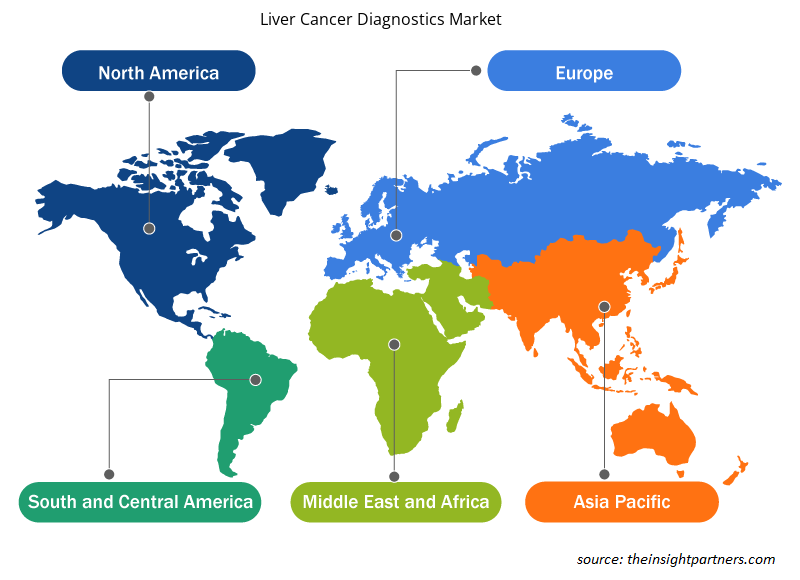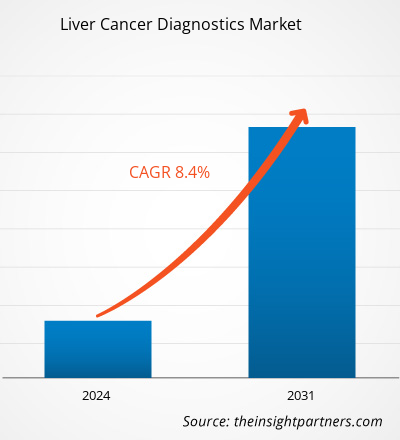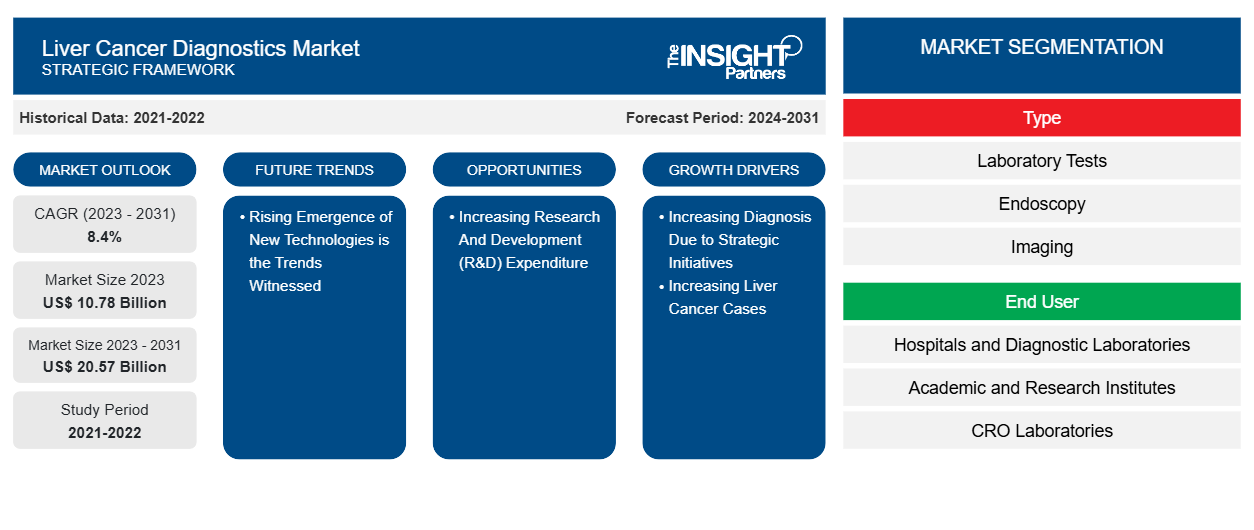Se prevé que el tamaño del mercado de diagnóstico de cáncer de hígado alcance los 20.570 millones de dólares en 2031, frente a los 10.780 millones de dólares en 2023. Se espera que el mercado registre una CAGR del 8,4 % durante el período 2023-2031. Es probable que la creciente aparición de nuevas tecnologías siga siendo una tendencia clave en el mercado.
Análisis del mercado de diagnóstico del cáncer de hígado
Según los CDC, cada año en los Estados Unidos, aproximadamente 24.500 hombres y 10.000 mujeres desarrollan cáncer de hígado, de los cuales 18.600 hombres y 9.000 mujeres mueren a causa de la enfermedad. Los casos de cáncer de hígado en los estadounidenses están aumentando desde hace varias décadas. El carcinoma hepatocelular (CHC) es el cáncer de hígado más común en los EE. UU. Además, según el gobierno de Canadá, aproximadamente 1 de cada 4 adultos canadienses (26,6 %) vive actualmente con obesidad. Los casos de obesidad también están aumentando y, con el aumento de casos, también aumenta el riesgo de ciertas afecciones de salud, como daño hepático, diabetes, presión arterial alta y enfermedades cardíacas.
Descripción general del mercado de diagnóstico del cáncer de hígado
En el año 2020, la Organización Mundial de la Salud (OMS) afirmó que en todo el mundo se produjeron más de 10 millones de muertes, de las cuales una de cada seis muertes se debe al cáncer. Además, en 2020, el cáncer de hígado es uno de los tipos de cáncer más comunes, representando alrededor del 4,7% de todos los casos nuevos de cáncer y el 8,3% de todas las muertes por cáncer. De todos los casos de cáncer de hígado diagnosticados, entre el 75% y el 90% son carcinomas hepatocelulares (CHC), que tienen un impacto más significativo en las muertes relacionadas con el cáncer. Según el artículo publicado en CCO (Chinese Clinical Oncology), el cáncer hepatocelular (CHC) es una de las principales causas de muerte por cáncer en todo el mundo. Los procedimientos más utilizados para la detección del CHC son la prueba de alfafetoproteína sérica (AFP) y la ecografía hepática. Sin embargo, por sensibilidad, la prueba de AFP tiene una sensibilidad del 25% al 65% y la ecografía tiene una sensibilidad de más del 60%. El cáncer de hígado es un cáncer más común y los casos están aumentando. Por ejemplo, en el Reino Unido, se espera que las tasas de mortalidad por CHC aumenten un 14% para 2025, lo que representa el mayor aumento para cualquier tipo de cáncer.
Personalice este informe según sus necesidades
Obtendrá personalización en cualquier informe, sin cargo, incluidas partes de este informe o análisis a nivel de país, paquete de datos de Excel, así como también grandes ofertas y descuentos para empresas emergentes y universidades.
-
Obtenga las principales tendencias clave del mercado de este informe.Esta muestra GRATUITA incluirá análisis de datos, desde tendencias del mercado hasta estimaciones y pronósticos.
Factores impulsores y oportunidades del mercado de diagnóstico del cáncer de hígado
Aumento del diagnóstico gracias a iniciativas estratégicas para favorecer el mercado
En junio de 2020, los científicos del NCI desarrollaron una nueva prueba para detectar el carcinoma hepatocelular (CHC), la forma más común de cáncer de hígado. Esta prueba implica un análisis de sangre para investigar la exposición previa del paciente a ciertos virus. Este tipo de pruebas conducen a una detección y un diagnóstico tempranos, principalmente porque se detectan los cánceres en etapas tardías o avanzadas, que para entonces suelen ser incurables. Además, el NCI también lanzó el Programa de Cáncer de Hígado del CCR para desarrollar nuevos métodos de detección, diagnóstico y tratamiento tempranos, con el objetivo de mejorar los resultados de los pacientes con CHC. Además, los Institutos Nacionales de Salud (NIH) iniciaron su red de ensayos clínicos para evaluar las posibles ayudas y los problemas de las nuevas y prometedoras tecnologías de detección del cáncer y para regular los métodos eficientes para integrar estas innovaciones en los protocolos de atención estándar.
Aumento del gasto en investigación y desarrollo (I+D)
En 2021, el gasto en investigación y desarrollo (I+D) de Elecsys GALAD fue de 14.650 millones de dólares y en 2020 fue de 13.170 millones de dólares. Ha aumentado un 14% sobre una base básica. Además, la I+D de F. Hoffmann-La Roche Ltd ha aumentado principalmente para inversiones en etapas avanzadas en oncología, oftalmología y atención médica personalizada. Además, en junio de 2020, los científicos de los Institutos Nacionales de Salud (NIH) lanzaron análisis de sangre para mejorar la detección del cáncer de hígado que son administrados por investigadores del Instituto Nacional del Cáncer (NCI). Por lo tanto, las crecientes inversiones en I+D y el desarrollo de pruebas de diagnóstico para el cáncer de hígado están impulsando el mercado de diagnóstico del cáncer de hígado.
Análisis de segmentación del informe de mercado de diagnóstico de cáncer de hígado
Los segmentos clave que contribuyeron a la derivación del análisis del mercado de diagnóstico de cáncer de hígado son el tipo y el usuario final.
- Según el tipo, el mercado se divide en pruebas de laboratorio, endoscopia , imágenes, biopsia y otros. El segmento de pruebas de laboratorio tuvo una mayor participación de mercado en 2023.
- En función del usuario final, el mercado se divide en hospitales y laboratorios de diagnóstico, institutos académicos y de investigación y laboratorios CRO. El segmento de hospitales y laboratorios de diagnóstico tuvo una mayor participación de mercado en 2023.
Análisis de la cuota de mercado de diagnóstico del cáncer de hígado por geografía
El alcance geográfico del informe de mercado de diagnóstico de cáncer de hígado se divide principalmente en cinco regiones: América del Norte, Asia Pacífico, Europa, Medio Oriente y África, y América del Sur y Central.
América del Norte ha dominado el mercado y se prevé que Asia Pacífico crezca con la CAGR más alta en los próximos años. El crecimiento del mercado de Asia Pacífico se debe al aumento de la población de personas mayores y a la expansión de las opciones de tratamiento del cáncer de hígado. Debido a la implementación de procedimientos de diagnóstico mejorados para el cáncer de hígado en países como India y China, se espera que la región APAC tenga la CAGR más alta. A medida que mejore la rentabilidad de las soluciones de diagnóstico, se prevé que aumente la demanda de diagnósticos de cáncer de hígado en laboratorios de diagnóstico independientes en APAC. Los factores anteriores impulsarán el mercado de diagnóstico de cáncer de hígado.
Perspectivas regionales del mercado de diagnóstico del cáncer de hígado
Los analistas de Insight Partners explicaron en detalle las tendencias y los factores regionales que influyen en el mercado de diagnóstico de cáncer de hígado durante el período de pronóstico. Esta sección también analiza los segmentos y la geografía del mercado de diagnóstico de cáncer de hígado en América del Norte, Europa, Asia Pacífico, Oriente Medio y África, y América del Sur y Central.

- Obtenga datos regionales específicos para el mercado de diagnóstico de cáncer de hígado
Alcance del informe de mercado sobre diagnóstico de cáncer de hígado
| Atributo del informe | Detalles |
|---|---|
| Tamaño del mercado en 2023 | US$ 10,78 mil millones |
| Tamaño del mercado en 2031 | US$ 20,57 mil millones |
| CAGR global (2023 - 2031) | 8,4% |
| Datos históricos | 2021-2022 |
| Período de pronóstico | 2024-2031 |
| Segmentos cubiertos |
Por tipo
|
| Regiones y países cubiertos |
América del norte
|
| Líderes del mercado y perfiles de empresas clave |
|
Densidad de actores del mercado de diagnóstico de cáncer de hígado: comprensión de su impacto en la dinámica empresarial
El mercado de diagnóstico de cáncer de hígado está creciendo rápidamente, impulsado por la creciente demanda de los usuarios finales debido a factores como la evolución de las preferencias de los consumidores, los avances tecnológicos y una mayor conciencia de los beneficios del producto. A medida que aumenta la demanda, las empresas amplían sus ofertas, innovan para satisfacer las necesidades de los consumidores y aprovechan las tendencias emergentes, lo que impulsa aún más el crecimiento del mercado.
La densidad de actores del mercado se refiere a la distribución de las empresas o firmas que operan dentro de un mercado o industria en particular. Indica cuántos competidores (actores del mercado) están presentes en un espacio de mercado determinado en relación con su tamaño o valor total de mercado.
Las principales empresas que operan en el mercado de diagnóstico de cáncer de hígado son:
- Abad,
- BioMerieux SA,
- F. HOFFMANN-LA ROCHE LTD,
- Illumina, Inc.,
- Philips NV, una empresa de telecomunicaciones de renombre mundial.
- QIAGEN,
Descargo de responsabilidad : Las empresas enumeradas anteriormente no están clasificadas en ningún orden particular.

- Obtenga una descripción general de los principales actores clave del mercado de diagnóstico de cáncer de hígado
Noticias y desarrollos recientes del mercado de diagnóstico del cáncer de hígado
El mercado de diagnóstico del cáncer de hígado se evalúa mediante la recopilación de datos cualitativos y cuantitativos posteriores a la investigación primaria y secundaria, que incluye publicaciones corporativas importantes, datos de asociaciones y bases de datos. A continuación, se enumeran algunos de los avances en el mercado de diagnóstico del cáncer de hígado:
- Illumina, Inc. lanzó la prueba oncológica TruSight para evaluar múltiples genes y biomarcadores tumorales. La prueba TruSight pronto comenzará su lanzamiento global en Europa. Evalúa los genes y biomarcadores tumorales para descubrir el perfil molecular específico del cáncer de un paciente, lo que ayuda a fundamentar las decisiones de medicina de precisión. (Fuente: Illumina, Inc., comunicado de prensa, marzo de 2022)
- Perspectum se asoció con HepQuant para brindar la tecnología de evaluación de la función hepática de HepQuant a través de los servicios de la Organización de Investigación por Contrato (CRO) de Perspectum. Esta colaboración permitió que las compañías farmacéuticas que respaldan los ensayos clínicos para enfermedades hepáticas, incluidas la cirrosis hepática, la esteatohepatitis no alcohólica (NASH), las enfermedades hepáticas autoinmunes y el cáncer de hígado, recibieran conocimientos sobre imágenes y pruebas funcionales de las Soluciones Farmacéuticas de Perspectum. (Fuente: Perspectum, comunicado de prensa, noviembre de 2021)
Cobertura y resultados del informe de mercado sobre diagnóstico de cáncer de hígado
El informe “Tamaño y pronóstico del mercado de diagnóstico de cáncer de hígado (2021-2031)” proporciona un análisis detallado del mercado que cubre las siguientes áreas:
- Tamaño del mercado de diagnóstico de cáncer de hígado y pronóstico a nivel mundial, regional y nacional para todos los segmentos clave del mercado cubiertos bajo el alcance
- Tendencias del mercado de diagnóstico de cáncer de hígado, así como dinámica del mercado, como impulsores, restricciones y oportunidades clave
- Análisis detallado de las cinco fuerzas de Porter y PEST y FODA
- Análisis del mercado de diagnóstico de cáncer de hígado que abarca las tendencias clave del mercado, el marco global y regional, los principales actores, las regulaciones y los desarrollos recientes del mercado3
- Análisis del panorama de la industria y de la competencia que abarca la concentración del mercado, el análisis de mapas de calor, los actores destacados y los desarrollos recientes en el mercado de diagnóstico del cáncer de hígado
- Perfiles detallados de empresas
- Análisis histórico (2 años), año base, pronóstico (7 años) con CAGR
- Análisis PEST y FODA
- Tamaño del mercado, valor/volumen: global, regional y nacional
- Industria y panorama competitivo
- Conjunto de datos de Excel
Informes recientes
Informes relacionados
Testimonios
Razón para comprar
- Toma de decisiones informada
- Comprensión de la dinámica del mercado
- Análisis competitivo
- Información sobre clientes
- Pronósticos del mercado
- Mitigación de riesgos
- Planificación estratégica
- Justificación de la inversión
- Identificación de mercados emergentes
- Mejora de las estrategias de marketing
- Impulso de la eficiencia operativa
- Alineación con las tendencias regulatorias























 Obtenga una muestra gratuita para - Mercado de diagnóstico del cáncer de hígado
Obtenga una muestra gratuita para - Mercado de diagnóstico del cáncer de hígado